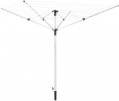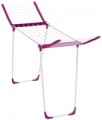Installation
—
Floor. These dryers come with their own stands, allowing them to be placed directly on the floor, as the name suggests. The design of these devices varies—some resemble tables or ironing boards, while others resemble ladders, etc. Despite their relatively large weight, floor models are easy to install — simply unfold the dryer into its working position and place it on a flat surface. However, this option is less suitable for confined spaces with limited floor space. Almost invariably, floor dryers feature a folding design (refer below).
—
Wall. This dryer type requires attachment to the wall using screws, nails, or similar devices. Usually featuring a sliding design (see below), these dryers are more compact than their floor-standing counterparts and can be utilized in spaces with limited floor area, such as balconies. However, the drawback of this option lies in the installation complexity and its unsuitability for mobility, as wall dryers are typically designed for permanent use in a fixed location.
—
Suspended. Similar to wall dryers (see above), these dryers are positioned at a specific height above the ground, eliminating floor space usage. A distinctive feature is their built-in mounts, often in the form of hooks. These mounts enable the dryer to be hung on various supports, such as balcony railings, heating radiators, or the edge of a shower c
...abin. Installation and removal take only seconds, allowing for easy relocation, for example, from the edge of the bathtub to the balcony for final air drying. However, the range of suitable locations is somewhat limited, some may not match the mount size, and these mounts are not as secure as wall mounts.
— Ceiling. True to its name, this dryer type is intended for ceiling mounting, often using liana-type structures (see below). Ceiling models share similar advantages and disadvantages with the wall-mounted ones described earlier, but in this case, both aspects are more pronounced. These constructions not only conserve floor space but also elevate items for drying to a greater height. However, their installation is considerably complex both procedurally and due to heightened reliability requirements.
— Wall/ceiling. Dryers equipped with universal mounts that allow you to install them both on the wall and on the ceiling, as desired. Features of both installation options are described above; here we note that in general, in terms of design, these models are closer to the ceiling ones, since the “liana” option is most often used.
— Over the bath. Many of these models feature an inverted V-shaped design, providing a practical function for drying delicate items that cannot be spun. This design allows water to drain directly into the bath, making it convenient. It's especially beneficial for apartments where the bathroom serves as the ideal space for drying clothes.
It's worth noting that, in theory, hanging dryers can also be affixed to the bath (refer to "Type"); however, the practical feasibility varies significantly depending on the features of each specific model. Therefore, the full possibility of installation on a bath cannot be universally asserted in this case, and this function is not specified in the characteristics of hanging dryers.
— Street (outdoor). Outdoor dryers, by nature, feature a robust design incorporating materials resistant to moisture, UV radiation, and temperature extremes. Additionally, their expansive working surface (refer below) is a notable characteristic. Numerous models are specifically designed for direct installation into the ground, making them suitable for private courtyards, summer cottages, and similar settings. Wall-mounted options are also available, typically in a more compact size.Legs
The shape of the
legs plays a crucial role in both the aesthetic and practical aspects of floor dryers.
—
U-shaped. Floor dryers featuring two U-shaped legs provide stability during use and reduce the risk of tipping. These legs are typically positioned at slight angles to the floor, often with a plastic lining on the lower crossbar. U-shaped legs offer the convenience of easy vacuuming underneath the dryer or placing objects under it.
—
X-shaped. Many floor clothes dryers feature legs arranged in a crosswise manner. These legs unfold together in a single motion, simplifying the setup process. When folded, the X-shaped legs neatly align with the dryer's main body, where the drying bars are situated. The design prevents any obstruction from the sides.
—
A-shaped. Dryers with A-shaped legs use support points formed by crossbars resembling the letter "A." These legs extend from a central upper point within the dryer's working area and are positioned at slight angles to each other. To enhance stability, they are frequently connected by a jumper. A-shaped legs often function as a miniature version of a fulcrum.
Total working surface
Under the total working surface is meant the total length of all drying rods in the expanded state. The
longer this length, the more laundry can be placed on the dryer and, usually, its maximum load is higher (see below). At the same time, this parameter also affects the dimensions and price of the device.
Number of rods
The number of individual rods provided for in the design of the drying rack. The more such rods are provided for with the same total working surface, the shorter the length of each of them and the more compact the dimensions of the device in the unfolded state can be. On the other hand, short rods are poorly suited for sheets, blankets and other large items.
Side wings
The side wings are additional folding shelves, provided mainly in floor models (see "Type") and installed at the ends. Such shelves allow, if necessary, to increase the usable area, and when not in use, they usually fit directly on the main work surface and do not take up extra space in the surrounding space.
Material
The main material from which the dryer is made.
— Aluminium. These models, crafted from lightweight and usually affordable aluminum alloys, come with both low weight and cost. However, compared to steel, inexpensive aluminum alloys typically lag behind in terms of strength and durability. Additionally, continuous exposure to water may cause oxidation, resulting in potential stains. While high-quality alternatives address these issues, they come with a corresponding increase in cost.
— Steel. Modern dryers typically utilize two main types of steel: regular and stainless. Ordinary steel boasts good strength at a low cost, although it is heavier than aluminum, which is not a critical factor. However, ordinary steel is prone to rust when exposed to moisture, necessitating protective coatings that can compromise the product's reliability and durability. On the other hand, stainless steel shares the same advantages but is corrosion-resistant and offers long-term use. Its main drawback is the higher price.
— Aluminium/steel. Two design types fit into this category. The first involves combined products, where the stand and main frame are typically crafted from steel, while the bars are made of aluminum. As detailed above, both materials have their characteristics, and combining them slightly boosts the strength and reliability of the dryer while keeping costs low. Additionally, models are available in various materials, including "aluminum/stee...l."
— Plastic. The main advantage of plastic as a material for dryers is complete chemical inertness — in other words, it does not oxidize from constant contact with moisture. At the same time, in terms of strength, plastic significantly loses to metals. Therefore, this option is used mainly in small-sized designs that are not designed for a large amount of laundry.
Dimensions (unfolded)
General dimensions of the drying rack in working position, taking into account all additional elements — side wings (see above), retractable parts (see "Design"), etc. This parameter will allow you to estimate how much space is required to use a particular model.

